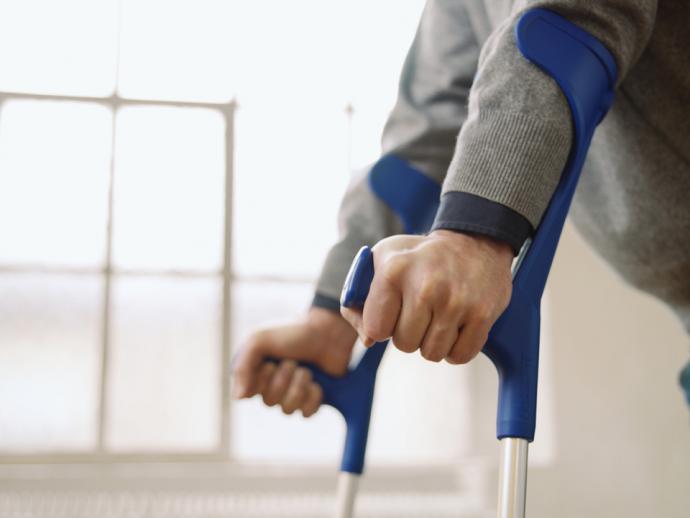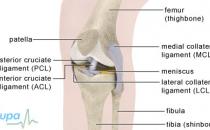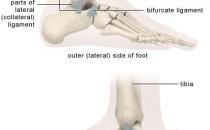Anterior cruciate ligament (ACL) reconstruction

An ACL reconstruction involves replacing the anterior cruciate ligament in the knee. It’s done to improve the stability and the function of the knee, often after an injury.
Your care will be adapted to meet your individual needs and may differ from what is described here. So it’s important that you follow your surgeon’s advice.
About ACL reconstruction
The anterior cruciate ligament (ACL) is a strong ligament that runs through the centre of the knee. It controls the stability and the movement of the knee. It’s usually damaged by twisting or overextending the knee, often combined with slowing down very quickly, especially during sports. The common causes are football and skiing.
ACL reconstruction involves replacing the anterior cruciate ligament of the knee with a graft. The graft is usually a section of tendon taken from another part of your knee, but sometimes it’s a donor graft (allograft). At the moment, synthetic grafts are not recommended. Your surgeon will discuss the different graft options with you.
The operation is normally performed using a narrow, tube-like telescopic camera called an arthroscope. This means that the surgeon will only make several small cuts to examine the inside of the knee and to replace your torn ACL. Getting the donor graft will also need one or two additional small cuts in the skin.
What are the alternatives?
For some people, ACL reconstruction isn’t necessary. Knee instability can often be managed by appropriate physiotherapy, maintenance exercises and by stopping vigorous sports. However, if your symptoms interfere with your everyday life and sporting activities and physiotherapy hasn’t helped, ACL reconstruction is an option.
Preparing for your operation
Your surgeon will explain how to prepare for your operation. For example, if you smoke, you will be asked to stop as smoking increases your risk of getting a chest and wound infection, which can slow your recovery.
ACL reconstruction can be done under general anaesthesia, which means that you will be asleep during the procedure, with an overnight stay. The operation can also be done under local or regional anaesthesia as a day case. This completely blocks feeling from the knee and the leg, and you will stay awake during the operation. You may be offered sedation with a regional anaesthetic to help you relax during the operation.
If you're having a general anaesthetic, you will be asked to follow fasting instructions. Typically you must not eat or drink for about six hours before a general anaesthetic. However, some anaesthetists allow occasional sips of water until two hours beforehand.
At the hospital your nurse may check your heart rate and blood pressure, and test your urine.
Your surgeon, will ask you to sign a consent form. This confirms that you understand the risks, benefits and possible alternatives to the procedure and have given your permission for it to go ahead.
About the operation
A number of small incisions (usually less than 10mm long) are made in the skin over the knee that is being treated. Your surgeon will insert the arthroscope and other surgical instruments into the knee through these cuts. Sterile fluid is put into the joint to help extend the joint and get a clearer picture of the inside of the joint. Your surgeon will then trim the torn ligament and prepare the knee for the replacement graft.
A graft will usually be taken from your patella tendon, which connects the patella (knee cap) and the tibia, or part of your hamstring tendon. Your surgeon will then drill a tunnel up through your upper shin bone (tibia) and lower thigh bone (femur), diagonally from the inside of your knee to the outside, above your knee.
The graft will be inserted in the tunnel, attached to the bones and fixed in place, usually with screws. The incisions are closed with stitches or adhesive strips. The operation usually lasts one to two hours.
What to expect afterwards
You will need to rest until the effects of the anaesthetic have passed. General anaesthesia temporarily affects your coordination and reasoning skills, so you must not drive, drink alcohol, operate machinery or sign legal documents for 48 hours afterwards. If you're in any doubt about driving, contact your motor insurer so that you're aware of their recommendations, and always follow your surgeon’s advice.
After a regional anaesthetic it may take several hours before the feeling comes back into the treated knee. Take special care not to bump or knock the area.
When you feel ready, you can begin to drink and eat, starting with clear fluids. Dressings will cover the small wounds and a bandage will support your knee and help to control swelling. You will be encouraged to move your knee soon after surgery to stop the joint becoming stiff.
You will need to arrange for someone to drive you home. You should try to have a friend or relative stay with you for the first 24 hours.
Your nurse will give you some advice about caring for your healing wounds before you go home. You may be given a date for a follow-up appointment.
You will also see a physiotherapist who will give you some exercises to do while you recover. The amount of physiotherapy you need varies, so follow the advice of your physiotherapist and surgeon.
Recovering from ACL reconstruction
It can take between six and 12 months for you to recover your knee function after an ACL reconstruction. However, this depends on the individual so you should follow your surgeon’s advice on returning to your usual physical activities and sports. You must also follow your surgeon's advice about driving and returning to work. You shouldn't drive until you’re confident that you could perform an emergency stop without discomfort.
If you need pain relief, you can take over-the-counter painkillers such as paracetamol or ibuprofen. Always read the patient information that comes with your medicine and if you have any questions, ask your pharmacist for advice.
You can also apply ice packs (eg frozen peas wrapped in a towel) to your knee to help reduce any pain and swelling. Don’t apply ice directly to your skin as it can damage your skin.
What are the risks?
Anterior cruciate ligament reconstruction is commonly performed and generally safe. However, in order to make an informed decision and give your consent, you need to be aware of the possible side-effects and the risk of complications of this procedure.
- Side-effects
- These are the unwanted but mostly temporary effects you may get after having the procedure.
You should expect some pain, stiffness, swelling and bruising around your treated knee. This is likely to last for some weeks and will gradually improve as the knee heals and as you get back to your normal day-to-day activities.
- Complications
- Complications are problems that occur during or after the operation. Most people aren’t affected. The possible complications of any operation include an unexpected reaction to the anaesthetic, infection, excessive bleeding or developing a blood clot, usually in a vein in the leg (deep vein thrombosis).
Complications specific to ACL reconstruction include the following.
- Infection of the wound or joint. Antibiotics are given during surgery to help prevent this. Joint infections are rare following an ACL reconstruction, but if this happens you may need arthroscopic wash-out of the knee joint and a long course of antibiotics.
- A small risk of damage to nearby nerves or blood vessels. Nerve damage could result in altered sensation or loss of feeling in the skin over the knee.
- Over time, the graft may tear or stretch, or scar tissue may form around it. The screws that fix the graft in place may also come loose. If this happens, you may need further surgery.
- If the replacement tendon graft is taken from your patella or quadriceps tendon, there is a possibility that the tendon may become tender or painful (patella or quadriceps tendinosis) or that the kneecap may be more susceptible to cartilage damage or fracture in the future.
- For some people knee pain and function doesn't improve and further surgery may be needed.
- Limited straightening and bending of your knee usually improves with physiotherapy and exercising, but may occasionally need further surgery.
- Severe pain, stiffness and gradual loss of function of the knee (CRPS or Complex Regional Pain Syndrome): this is a rare condition and the cause is unknown. If this happens, it may take months or years for your knee to get better.
The exact risks are specific to you and differ for every person, so we have not included statistics here. Ask your surgeon to explain how these risks apply to you.
This section contains answers to common questions about this topic. Questions have been suggested by health professionals, website feedback and requests via email.
How will I know I have injured my anterior cruciate ligament?
Answer
If you have damaged your anterior cruciate ligament, your knee may be painful and swollen. Many people also hear a ‘pop’ when the injury occurs.
Explanation
Anterior cruciate ligament injuries normally happen while you’re playing sports, especially if you twist or overextend your knee. These injuries can also be caused by a blow to the knee, for example, a tackle during football or rugby.
When you first damage your anterior cruciate ligament, your knee may be painful and swollen. Many people also hear a ‘pop’ or feel something break in the knee when the injury occurs. Over time, the swelling may reduce without any treatment.
Some people don’t have any pain or symptoms, such as weakness or collapsing of the knee, when they damage their anterior cruciate ligament. Others may only have pain or symptoms when their knee is under stress, for example during sports.
If you damage your anterior cruciate ligament during exercise or while playing a sport, stop and don’t attempt to move the knee. Gently support the knee joint in the most comfortable position and get urgent medical attention. You may find it more comfortable to put some padding under the knee so it’s not completely flat against the floor.
If you have already damaged your anterior cruciate ligament and it’s affecting your everyday life, talk to your doctor about your options.
What are the different types of graft used in ACL reconstruction?
Answer
There are three different types of graft available for ACL reconstruction – autografts, allografts and synthetic grafts. Your surgeon will discuss your options with you.
Explanation
Autografts are grafts taken from your body. They are either part of your patella tendon, which connects the patella and the tibia, or part of your hamstring. There is very little difference between a graft from your patella tendon or your hamstring.
The patella tendon is often seen as the best option for ACL reconstruction as it has a slightly better functional success rate than a hamstring graft. This success rate is based on the number of reconstructions that don’t work. However, more people have anterior knee pain (pain behind their patella), especially when kneeling, after having a patella tendon graft. You may also have problems flexing your knee as well as you did before the operation.
Hamstring tendon grafts are thought to cause less pain after surgery and are linked with less invasive surgery. However, some research has suggested the hamstring tendon graft is more likely to stretch after surgery, which may reduce the stability of the knee.
Allografts are donor grafts and are often used if you have had a failed ACL reconstruction in the past. This second ACL reconstruction is known as a revision. Having this type of graft may mean you’re slightly more likely to get an infection and some studies have suggested these grafts are also more likely to stretch after surgery.
Synthetic grafts are manmade and are not used in the UK or recommended by the British Orthopaedic Association at the moment.
Will I need to wear a knee brace after surgery?
Answer
At the moment, there is no evidence to support the routine use of a brace after knee surgery.
Explanation
Knee braces are sometimes used after surgery to support the knee and to prevent any other knee injuries. You may also find that wearing a knee brace is reassuring because your knee feels supported, although a brace is often too bulky and awkward to wear most of the time. However, there have not been enough good quality studies published to support their use. Talk to your surgeon about the options available to you and any concerns you have about returning to normal activities.
Further information
-
British Orthopaedic Association
020 7405 6507
www.boa.ac.uk
Sources
- Aichroth PM, Cannon WD. Knee surgery: current practice. Abingdon: Taylor & Francis Ltd, 1992:132
- Best practice for primary isolated anterior cruciate ligament reconstruction. British Orthopaedic Association, 2001, www.boa.ac.uk
- Anterior Cruciate Ligament Pathology: Treatment. eMedicine. www.emedicine.com, accessed 6 January 2009
- Anterior cruciate ligament (ACL) injury. Medline Plus. www.nlm.nih.gov, accessed 6 January 2009
- MacAuley D. Oxford handbook of sport and exercise medicine. Oxford Handbooks. Oxford: Oxford University Press, 2006:226-27
- Dandy DJ, Edwards DJ. Essential orthopaedics and trauma. 3rd ed. Oxford: Churchill Livingstone, 1998:407
- Smoking and surgery. British Association of Day Surgery. www.daysurgeryuk.org, accessed 1 December 2008
- Good practice in consent implementation guide: consent to examination or treatment. Department of Health, 2001, www.dh.gov.uk
- Knee Arthroscopy. American Academy of Orthopaedic Surgeons. www.orthoinfo.aaos.org, accessed 7 January 2009
- MacPherson G. Black's medical dictionary. 39th ed. London: A & C Black, 1999:302
- ACL injury: does it require surgery? American Academy of Orthopaedic Surgeons. www.orthoinfo.aaos.org, accessed 7 January 2009
This information was published by Bupa’s health information team and is based on reputable sources of medical evidence. It has been peer reviewed by Bupa doctors. The content is intended for general information only and does not replace the need for personal advice from a qualified health professional.
















